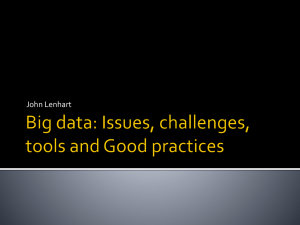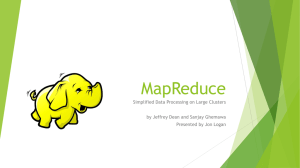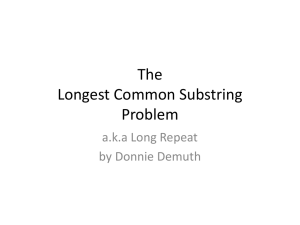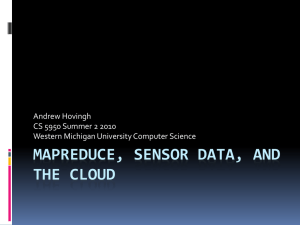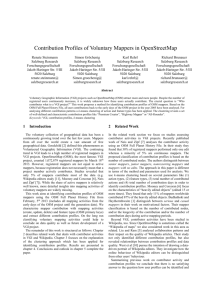Have fun with Hadoop
advertisement
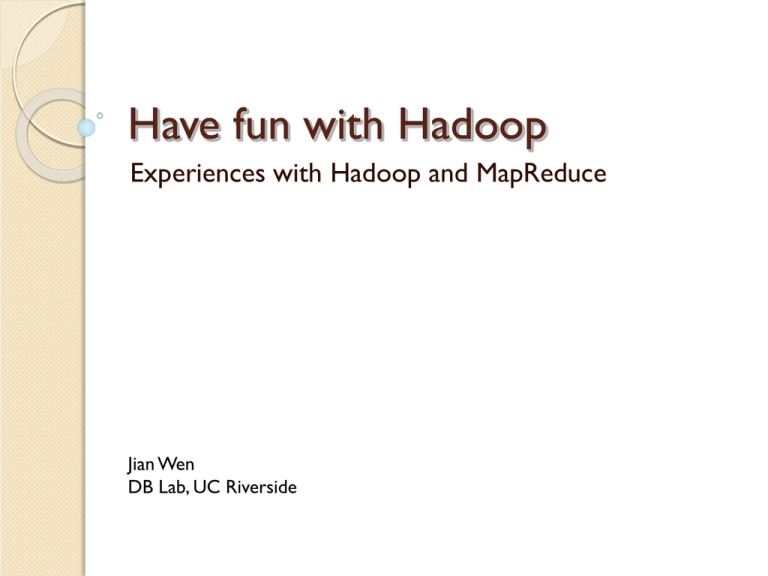
Have fun with Hadoop Experiences with Hadoop and MapReduce Jian Wen DB Lab, UC Riverside Outline Background on MapReduce Summer 09 (freeman?): Processing Join using MapReduce Spring 09 (Northeastern): NetflixHadoop Fall 09 (UC Irvine): Distributed XML Filtering Using Hadoop Background on MapReduce Started from Winter 2009 ◦ Course work: Scalable Techniques for Massive Data by Prof. Mirek Riedewald. ◦ Course project: NetflixHadoop Short explore in Summer 2009 ◦ Research topic: Efficient join processing on MapReduce framework. ◦ Compared the homogenization and map-reducemerge strategies. Continued in California ◦ UCI course work: Scalable Data Management by Prof. Michael Carey ◦ Course project: XML filtering using Hadoop MapReduce Join: Research Plan Focused on performance analysis on different implementation of join processors in MapReduce. ◦ Homogenization: add additional information about the source of the data in the map phase, then do the join in the reduce phase. ◦ Map-Reduce-Merge: a new primitive called merge is added to process the join separately. ◦ Other implementation: the map-reduce execution plan for joins generated by Hive. MapReduce Join: Research Notes Cost analysis model on process latency. ◦ The whole map-reduce execution plan is divided into several primitives for analysis. Distribute Mapper: partition and distribute data onto several nodes. Copy Mapper: duplicate data onto several nodes. MR Transfer: transfer data between mapper and reducer. Summary Transfer: generate statistics of data and pass the statistics between working nodes. Output Collector: collect the outputs. Some basic attempts on theta-join using MapReduce. ◦ Idea: a mapper supporting multi-cast key. NetflixHadoop: Problem Definition From Netflix Competition ◦ Data: 100480507 rating data from 480189 users on 17770 movies. ◦ Goal: Predict unknown ratings for any given user and movie pairs. ◦ Measurement: Use RMSE to measure the precise. Out approach: Singular Value Decomposition (SVD) NetflixHadoop: SVD algorithm A feature means… ◦ User: Preference (I like sci-fi or comedy…) ◦ Movie: Genres, contents, … ◦ Abstract attribute of the object it belongs to. Feature Vector ◦ Each user has a user feature vector; ◦ Each movie has a movie feature vector. Rating for a (user, movie) pair can be estimated by a linear combination of the feature vectors of the user and the movie. Algorithm: Train the feature vectors to minimize the prediction error! NetflixHadoop: SVD Pseudcode Basic idea: ◦ Initialize the feature vectors; ◦ Recursively: calculate the error, adjust the feature vectors. NetflixHadoop: Implementation Data Pre-process ◦ Randomize the data sequence. ◦ Mapper: for each record, randomly assign an integer key. ◦ Reducer: do nothing; simply output (automatically sort the output based on the key) ◦ Customized RatingOutputFormat from FileOutputFormat Remove the key in the output. NetflixHadoop: Implementation Feature Vector Training ◦ Mapper: From an input (user, movie, rating), adjust the related feature vectors, output the vectors for the user and the movie. ◦ Reducer: Compute the average of the feature vectors collected from the map phase for a given user/movie. Challenge: Global sharing feature vectors! NetflixHadoop: Implementation Global sharing feature vectors ◦ Global Variables: fail! Different mappers use different JVM and no global variable available between different JVM. ◦ Database (DBInputFormat): fail! Error on configuration; expecting bad performance due to frequent updates (race condition, query start-up overhead) ◦ Configuration files in Hadoop: fine! Data can be shared and modified by different mappers; limited by the main memory of each working node. NetflixHadoop: Experiments Experiments using single-thread, multi-thread and MapReduce Test Environment ◦ Hadoop 0.19.1 ◦ Single-machine, virtual environment: Host: 2.2 GHz Intel Core 2 Duo, 4GB 667 RAM, Max OS X Virtual machine: 2 virtual processors, 748MB RAM each, Fedora 10. ◦ Distributed environment: 4 nodes (should be… currently 9 node) 400 GB Hard Driver on each node Hadoop Heap Size: 1GB (failed to finish) 1 mapper v.s. 2 mappers 1 mapper v.s. 2 mapper2 Randomizer Learner 60 120 50 100 40 80 1 mapper 2 mappers 30 20 Time (sec) Time (sec) NetflixHadoop: Experiments 40 10 20 0 0 770919 113084 1502071 1894636 # of Records 1 mapper 2 mappers 60 770919 113084 1502071 1894636 # of Records NetflixHadoop: Experiments Mappers 123 on 1894636 ratings Types Randomizer 1 mapper 2 mappers 3 mappers 2 mappers+c Vector Initializer Learner 0 20 40 60 Time (sec) 80 100 120 NetflixHadoop: Experiments XML Filtering: Problem Definition Aimed at a pub/sub system utilizing distributed computation environment ◦ Pub/sub: Queries are known, data are fed as a stream into the system (DBMS: data are known, queries are fed). XML Filtering: Pub/Sub System XML Docs XML Filters XML Queries XML Filtering: Algorithms Use YFilter Algorithm ◦ YFilter: XML queries are indexed as a NFA, then XML data is fed into the NFA and test the final state output. ◦ Easy for parallel: queries can be partitioned and indexed separately. XML Filtering: Implementations Three benchmark platforms are implemented in our project: ◦ Single-threaded: Directly apply the YFilter on the profiles and document stream. ◦ Multi-threaded: Parallel YFilter onto different threads. ◦ Map/Reduce: Parallel YFilter onto different machines (currently in pseudo-distributed environment). XML Filtering: Single-Threaded Implementation The index (NFA) is built once on the whole set of profiles. Documents then are streamed into the YFilter for matching. Matching results then are returned by YFilter. XML Filtering: Multi-Threaded Implementation Profiles are split into parts, and each part of the profiles are used to build a NFA separately. Each YFilter instance listens a port for income documents, then it outputs the results through the socket. XML Filtering: Map/Reduce Implementation Profile splitting: Profiles are read line by line with line number as the key and profile as the value. ◦ Map: For each profile, assign a new key using (old_key % split_num) ◦ Reduce: For all profiles with the same key, output them into a file. ◦ Output: Separated profiles, each with profiles having the same (old_key % split_num) value. XML Filtering: Map/Reduce Implementation Document matching: Split profiles are read file by file with file number as the key and profiles as the value. ◦ Map: For each set of profiles, run YFilter on the document (fed as a configuration of the job), and output the old_key of the matching profile as the key and the file number as the values. ◦ Reduce: Just collect results. ◦ Output: All keys (line numbers) of matching profiles. XML Filtering: Map/Reduce Implementation XML Filtering: Experiments Hardware: ◦ Macbook 2.2 GHz Intel Core 2 Duo ◦ 4G 667 MHz DDR2 SDRAM Software: ◦ Java 1.6.0_17, 1GB heap size ◦ Cloudera Hadoop Distribution (0.20.1) in a virtual machine. Data: ◦ XML docs: SIGMOD Record (9 files). ◦ Profiles: 25K and 50K profiles on SIGMOD Record. Data Size 1 2 3 4 5 6 7 8 9 478416 415043 312515 213197 103528 53019 42128 30467 20984 XML Filtering: Experiments Run-out-of-memory: We encountered this problem in all the three benchmarks, however Hadoop is much robust on this: ◦ Smaller profile split ◦ Map phase scheduler uses the memory wisely. Race-condition: since the YFilter code we are using is not thread-safe, in multi-threaded version race-condition messes the results; however Hadoop works this around by its shared-nothing run-time. ◦ Separate JVM are used for different mappers, instead of threads that may share something lower-level. XML Filtering: Experiments Thousands Time Costs for Splitting 45 40 35 30 25 Time(ms) 20 15 10 5 0 Single 2M2R: 2S 2M2R: 4S 2M2R: 8S 4M2R: 4S XML Filtering: Experiments Map/Reduce: # of Splits on Profiles 0:03:36 There are memory failures, and jobs are failed too. Time 0:02:53 0:02:10 2 split 4 split 6 split 8 split 0:01:26 0:00:43 0:00:00 0 1 2 3 4 5 Tasks 6 7 8 9 XML Filtering: Experiments Map/Reduce: # of Mappers 0:04:19 0:03:36 Time 0:02:53 0:02:10 2M2R 4M2R 0:01:26 0:00:43 0:00:00 0 1 2 3 4 5 Tasks 6 7 8 9 XML Filtering: Experiments Map/Reduce: # of Profiles 0:08:38 There are memory failures but recovered. 0:07:12 Time 0:05:46 0:04:19 25K 50K 0:02:53 0:01:26 0:00:00 0 1 2 3 4 5 Tasks 6 7 8 9 Questions?
